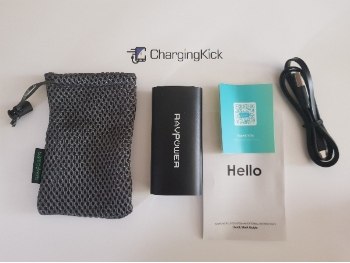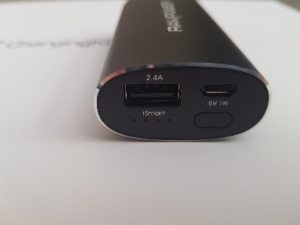Review: RAVPower 6700mAh

The RAVPower 6700 mAh is one of the most popular small power banks on the market. Slightly bigger than a typical power bank gives extra energy. How good is it really? Read on to find out.


Pros & Cons:
Pros:
Nicely looking power bank
Solid recharging speed
Convenient shape
Cons:
Slow charging speed
Not-efficient battery
Rating
Power & Performance (1 to 5 stars)
Design & Build (1 to 5 stars)
Technology (1 to 5 stars)
Overall Rating (average of above)
Key Product Specifications
Key Specs:
Capacity
6700 mAh / 24.7 Wh
Dimensions (LxWxH)
3.5 x 1.7 x 0.9 in / 8.9 x 4.3 x 2.3 cm
Weight
5.2 oz / 149 g
Output & Input Charging:
Average Charging Time of a Mobile Phone (average battery capacity 3000mAh)
1 hour and 55 minutes
Average Recharging Time (from 0% to 100%)
3 hours and 45 minutes
Ports
- USB-A Output: 5V/2.4A
- Micro USB Input: 5V/2A
Charging Technology
- Exclusive iSmart Technology - automatically detects and delivers the optimal charging current for any connected device
- Premium Panasonic battery cell
Flight Status
Under 100 Wh
Safe to take on board.
Other Features
- 18 months warranty with extra 12 months if it’s registered on the manufacturer’s website.
Ideal For?
- Commuters
- Students
- Businesspeople
- Adventurers
What’s Inside?
- RAVPower 6700mAh Portable Charger
- Travel pouch
- User Manual
- Micro USB Cable

Power & Performance
Battery Capacity
Battery capacity in mAh and Watts
The RAVPower 6700 mAh is a small power bank with a battery capacity of 6,700 mAh / 24.7 Wh. This should be enough to charge most mobile phones at least once. Smaller phones should get two full charges.
Capacity test: discharge the fully charged power bank
Have you ever wondered whether a power bank has its battery capacity? Does it really have 5,000 mAh or 10,000 mAh, as advertised? What is the real battery capacity?
To check the actual battery capacity we need:
The fully charged power bank
A USB tester that shows the current, voltage, mAh, and charging time.
The USB mini adjustable load receives energy from the power bank and releases it safely via the fan. This is the safe way to discharge a fully charged power bank and measure the real battery capacity.
I connect the dummy load (amperes are set to 2) to the USB tester, then plug it into the fully charged power bank. Once that’s done, I wait until the power bank’s battery goes flat. The screen on the USB tester will display the Watt-hours and the amount of mAh consumed. These data show the real battery capacity.
Using the aforementioned procedure, I tested the RAVPower 6700 Power Bank. Here are the results:
Capacity Test

Results:
Discharge Time - 1 hour and 41 minutes
Watt-Hours - 17.8 Wh
Ampere hour - 3,540 mAh
The real battery capacity is 3,540 mAh. This mAh measurement shows you the energy you will fully use to charge your mobile phone. It’s not 6,700 mAh because the unit is converting energy from 3.7V (the power bank’s battery voltage) to 5V (USB voltage). This loss occurs in every power bank.
When you know the advertised and real battery capacity, it’s possible to measure the battery efficiency, which in this case is 71%. Manufacturers frequently don’t share this information. Efficiency above 90% is considered very good. 71% is the worst result amongst all power banks that have tested in Charging Kick so far. It’s very disappointing for such a reputable brand.
Disclaimer: Every test can produce different results, but only small variations.
How many times can you charge the most popular mobile phones in 2020?
To put the battery capacity into perspective, I will use a formula for Real Battery Capacity and calculate how many times the RAVPower 6700 Power Bank can charge the top 10 most popular mobile phones in 2020. Perhaps you own one of them, or at least you know your mobile phone’s battery capacity.
From the previous test, we know the real battery capacity is 3,540 mAh.
Once we know the real battery capacity, we simply divide it by the enlisted mobile phones’ battery capacity to find out how many times it can be charged.
Mobile Phone Model | How Many Times Can It Be Charged? |
4.61 | |
3.05 | |
2.88 | |
2.88 | |
3.24 | |
7.13 | |
2.88 | |
4.13 | |
3.09 | |
2.60 |
The power bank should be sufficient to charge all phones once, even those with big batteries. However, this extra 1,700 mAh of energy compare with typical small power banks, doesn’t give leverage and unlikely will be able to charge twice a phone with a medium battery.
Output Charging
Charging Time & Power Usage
Power banks are used mainly to charge devices. Therefore, this review would not be completed without testing output charging. For this, knowledge of the device’s charging time is crucial. Frequently it is one of the most important factors in the purchase of a power bank.
For these tests, I used two mobile phones:
Huawei P10 with a battery of 3200 mAh (Huawei SuperCharge)
Samsung S8 with a battery of 3000mAh (Adaptive Fast Charging)
Both phones support fast-charging technology.
To record data (current, voltage, mAh, time) I used a USB tester.
Real-life examples of test-charged phones demonstrate what you can expect after purchasing a power bank.
The tested power bank has an output rated at 2.4A. It basically means that it should charge most phones at a standard charging speed. In that case, a phone with a battery of 3,000 mAh should get a full charge within 90 minutes.
Charging via USB-A (Huawei)

2 hours and 8 minutes for a full charge! It’s a very disappointing time, far from acceptable. The phone received 2,262 mAh / 11.6 Wh of energy in total.
Charging via USB-A (Samsung)

The charging time for Samsung S8 was 1 hour and 51 minutes. It’s slightly better but still disappointing. The power bank delivered 1,879 mAh / 9.5 Wh.
Roundup of output charging
The test results are disappointing. I didn’t expect a fast charging and exceptional efficiency, but at least an average performance. Unfortunately, RAVPower disappointed a big one.
Input Charging
The RAVPower 6700 has a standard micro USB input port rated at 2A. The power bank should get a full blast in a maximum of 4 hours.
I charged the power bank twice. The first test, via a standard charger rated at 5V/2A charging speed; a charger most of us have. For the second charge, I used the charger rated 65W, the fastest type of charger, able to charge compatible laptops.
Recharging via Standard Charger

It took 3 hours and 35 minutes to charge the power bank with a standard charger. It’s a good time. The power bank received 4,808 mAh / 25.2 Wh of energy in total.
Recharging via Fast Charger

The fast-charger from the same brand needed 4 hours to charge the power bank. It was still a solid time, but surprisingly slower than expected. The power bank received 5,241 mAh / 26.8 Wh of energy.
Roundup of input charging
It’s an expected and acceptable time. You could manage to charge it over a studying/working session, but not fast enough for a lunch in a restaurant, as you could expect from a small power bank.
Score
Design & Build
Dimension & Weight
Weight in ounces and grams
- 5.2 oz / 149 g
Measurement in inches and centimeters
- 3.5 x 1.7 x 0.9 in / 8.9 x 4.3 x 2.3 cm
The RAVPower 6700 has everything that you need from a small power bank - low weight and small dimension. You can easily charge your phone on the go while having your phone and power bank in your pocket.
Design & Material
It’s a nice-looking power bank, with a typical design for RAVPower’s power banks - minimalistic and well-thought. It has a quite unusual shape, reminiscent of flatten tube with a big RAVPower logo in the middle.


It’s made of high-quality plastic. It has a matte finish, which prevents settling dust or lint on the device. The device stays firmly in hand. There are no loose parts, which makes it easy to slide into a pocket while charging a mobile phone. Its flatten-tube shape with USB ports on the top allows connecting cable while the power bank safely and conveniently stays in the pocket. The power bank is available in multiple colors such as black, white or silver.
On the top edge are USB ports: a micro USB for recharging the device and USB-A for charging external devices. Right below USB-A is 4 LED lights that indicate battery level. Below a micro USB port is the power button. On the other edge of the device is the technical specification.
Overall, it’s a nicely designed and constructed device that should satisfy most users.
Score
Technology
Ports
The power bank has two USB ports, one for recharging the device and one to charge external devices. They are standard ports.
USB-A Output: 5V/2.4A
Micro USB Input: 5V/2A

Tech
The RAVPower used its exclusive technology in this device: iSmart Technology. It is supposed to detect optimal charging speed for each device. Unfortunately, the tests showed quite the opposite result and the phones were charged below expectations.
Score
Conclusion
Overall Opinion
I wish to say it’s a good power bank. RAVPower makes great devices, but nobody is perfect and this device is a good example. The design and built are great, but the charging performance and quality of the battery deviate from an acceptable level.